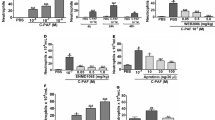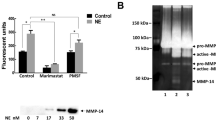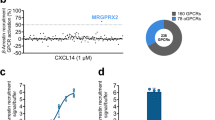Abstract
We describe the tripeptide neutrophil chemoattractant N-acetyl Pro-Gly-Pro (PGP), derived from the breakdown of extracellular matrix (ECM), which shares sequence and structural homology with an important domain on alpha chemokines. PGP caused chemotaxis and production of superoxide through CXC receptors, and administration of peptide caused recruitment of neutrophils (PMNs) into lungs of control, but not CXCR2-deficient mice. PGP was generated in mouse lung after exposure to lipopolysaccharide, and in vivo and in vitro blockade of PGP with monoclonal antibody suppressed PMN responses as much as chemokine-specific monoclonal antibody. Extended PGP treatment caused alveolar enlargement and right ventricular hypertrophy in mice. PGP was detectable in substantial concentrations in a majority of bronchoalveolar lavage samples from individuals with chronic obstructive pulmonary disease, but not control individuals. Thus, PGP's activity links degradation of ECM with neutrophil recruitment in airway inflammation, and PGP may be a biomarker and therapeutic target for neutrophilic inflammatory diseases.
This is a preview of subscription content, access via your institution
Access options
Subscribe to this journal
Receive 12 print issues and online access
$209.00 per year
only $17.42 per issue
Buy this article
- Purchase on SpringerLink
- Instant access to full article PDF
Prices may be subject to local taxes which are calculated during checkout






Similar content being viewed by others
References
Kobzik, L. The Lung. in Robbins Pathologic Basis of Disease (eds. Cotran, R.S., Kumar, V. & Collins, T.) (W.B. Saunders Company, Philadelphia, 1999).
Abraham, E., Carmody, A., Shenkar, R. & Arcaroli, J. Neutrophils as early immunologic effectors in hemorrhage- or endotoxemia-induced acute lung injury. Am. J. Physiol. Lung Cell. Mol. Physiol. 279, L1137–L1145 (2000).
Rot, A. & von Andrian, U.H. Chemokines in innate and adaptive host defense: basic chemokinese grammar for immune cells. Annu. Rev. Immunol. 22, 891–928 (2004).
Baggiolini, M., Dewald, B. & Moser, B. Human chemokines: an update. Annu. Rev. Immunol. 15, 675–705 (1997).
Weathington, N.M. & Blalock, J.E. The biology of CXC chemokines and their receptors. in Current Topics in Membranes Vol. 55 (ed. Schwiebert, L.M.) 49–71 (Elsevier, New York, 2005).
Cacalano, G. et al. Neutrophil and B cell expansion in mice that lack the murine IL-8 receptor homolog. Science 265, 682–684 (1994).
Chang, C. & Houck, J.C. Demonstration of the chemotactic properties of collagen. Proc. Soc. Exp. Biol. Med. 134, 22–26 (1970).
Postlethwaite, A.E. & Kang, A.H. Collagen-and collagen peptide-induced chemotaxis of human blood monocytes. J. Exp. Med. 143, 1299–1307 (1976).
Laskin, D.L., Kimura, T., Sakakibara, S., Riley, D.J. & Berg, R.A. Chemotactic activity of collagen-like polypeptides for human peripheral blood neutrophils. J. Leukoc. Biol. 39, 255–266 (1986).
Senior, R.M. et al. Neutrophils show chemotaxis to type IV collagen and its 7S domain and contain a 67 kD type IV collagen binding protein with lectin properties. Am. J. Respir. Cell Mol. Biol. 1, 479–487 (1989).
Pfister, R.R., Haddox, J.L., Sommers, C.I. & Lam, K.W. Identification and synthesis of chemotactic tripeptides from alkali-degraded whole cornea. A study of N-acetyl-proline-glycine-proline and N-methyl-proline-glycine-proline. Invest. Ophthalmol. Vis. Sci. 36, 1306–1316 (1995).
Pfister, R.R., Haddox, J.L. & Sommers, C.I. Alkali-degraded cornea generates a low molecular weight chemoattractant for polymorphonuclear leukocytes. Invest. Ophthalmol. Vis. Sci. 34, 2297–2304 (1993).
Pfister, R.R., Haddox, J.L. & Sommers, C.I. Injection of chemoattractants into normal cornea: a model of inflammation after alkali injury. Invest. Ophthalmol. Vis. Sci. 39, 1744–1750 (1998).
Riley, D.J. et al. Neutrophil response following intratracheal instillation of collagen peptides into rat lungs. Exp. Lung Res. 14, 549–563 (1988).
Foronjy, R.F., Okada, Y., Cole, R. & D'Armiento, J. Progressive adult-onset emphysema in transgenic mice expressing human MMP-1 in the lung. Am. J. Physiol. Lung Cell. Mol. Physiol. 284, L727–L737 (2003).
Selman, M. et al. Tobacco smoke-induced lung emphysema in guinea pigs is associated with increased interstitial collagenase. Am. J. Physiol. 271, L734–L743 (1996).
Corbel, M. et al. Repeated endotoxin exposure induces interstitial fibrosis associated with enhanced gelatinase (MMP-2 and MMP-9) activity. Inflamm. Res. 50, 129–135 (2001).
Hauert, A.B., Martinelli, S., Marone, C. & Niggli, V. Differentiated HL-60 cells are a valid model system for the analysis of human neutrophil migration and chemotaxis. Int. J. Biochem. Cell Biol. 34, 838–854 (2002).
Downs, J.T. et al. Analysis of collagenase-cleavage of type II collagen using a neoepitope ELISA. J. Immunol. Methods 247, 25–34 (2001).
Clark-Lewis, I., Dewald, B., Loetscher, M., Moser, B. & Baggiolini, M. Structural requirements for interleukin-8 function identified by design of analogs and CXC chemokine hybrids. J. Biol. Chem. 269, 16075–16081 (1994).
Baldwin, E.T. et al. Crystal structure of interleukin 8: symbiosis of NMR and crystallography. Proc. Natl. Acad. Sci. USA 88, 502–506 (1991).
Lee, Y.C. et al. NMR conformational analysis of cis and trans proline isomers in the neutrophil chemoattractant, N-acetyl-proline-glycine-proline. Biopolymers 58, 548–561 (2001).
Jones, S.A., Wolf, M., Qin, S., Mackay, C.R. & Baggiolini, M. Different functions for the interleukin 8 receptors (IL-8R) of human neutrophil leukocytes: NADPH oxidase and phospholipase D are activated through IL-8R1 but not IL-8R2. Proc. Natl. Acad. Sci. USA 93, 6682–6686 (1996).
Feniger-Barish, R., Yron, I., Meshel, T., Matityahu, E. & Ben-Baruch, A. IL-8-induced migratory responses through CXCR1 and CXCR2: association with phosphorylation and cellular redistribution of focal adhesion kinase. Biochemistry 42, 2874–2886 (2003).
Rennard, S.I. et al. Estimation of volume of epithelial lining fluid recovered by lavage using urea as marker of dilution. J. Appl. Physiol. 60, 532–538 (1986).
Otterness, I.G. et al. Detection of collagenase-induced damage of collagen by 9A4, a monoclonal C-terminal neoepitope antibody. Matrix Biol. 18, 331–341 (1999).
Shapiro, S.D. et al. Neutrophil elastase contributes to cigarette smoke-induced emphysema in mice. Am. J. Pathol. 163, 2329–2335 (2003).
Pfister, R.R., Haddox, J.L., Lam, K.W. & Lank, K.M. Preliminary characterization of a polymorphonuclear leukocyte stimulant isolated from alkali-treated collagen. Invest. Ophthalmol. Vis. Sci. 29, 955–962 (1988).
Belvisi, M.G. & Bottomley, K.M. The role of matrix metalloproteinases (MMPs) in the pathophysiology of chronic obstructive pulmonary disease (COPD): a therapeutic role for inhibitors of MMPs? Inflamm Res. 52, 95–100 (2003).
Churg, A. et al. Acute cigarette smoke-induced connective tissue breakdown requires both neutrophils and macrophage metalloelastase in mice. Am. J. Respir. Cell Mol. Biol. 27, 368–374 (2002).
Hautamaki, R.D., Kobayashi, D.K., Senior, R.M. & Shapiro, S.D. Requirement for macrophage elastase for cigarette smoke-induced emphysema in mice. Science 277, 2002–2004 (1997).
Clark-Lewis, I. et al. Structure-activity relationships of chemokines. J. Leukoc. Biol. 57, 703–711 (1995).
Adair-Kirk, T.L. et al. A site on laminin alpha 5, AQARSAASKVKVSMKF, induces inflammatory cell production of matrix metalloproteinase-9 and chemotaxis. J. Immunol. 171, 398–406 (2003).
Tomkinson, A. et al. A murine IL-4 receptor antagonist that inhibits IL-4- and IL-13-induced responses prevents antigen-induced airway eosinophilia and airway hyperresponsiveness. J. Immunol. 166, 5792–5800 (2001).
Grunig, G. et al. Requirement for IL-13 independently of IL-4 in experimental asthma. Science 282, 2261–2263 (1998).
Goodman, L.S., Hardman, J.G., Limbird, L.E. & Gilman, A.G. Goodman & Gilman's The Pharmacological Basis of Therapeutics, 10th Ed. (McGraw-Hill, New York, 2001).
Beeh, K.M. et al. Neutrophil chemotactic activity of sputum from patients with COPD: role of interleukin 8 and leukotriene B4. Chest 123, 1240–1247 (2003).
Haddox, J.L. et al. Bioactivity of peptide analogs of the neutrophil chemoattractant, N-acetyl-proline-glycine-proline. Invest. Ophthalmol. Vis. Sci. 40, 2427–2429 (1999).
Horvath, I., Hunt, J. & Barnes, P.J. Exhaled breath condensate: methodological recommendations and unresolved questions. Eur. Respir. J. 26, 523–548 (2005).
Mahler, D.A., Huang, S., Tabrizi, M. & Bell, G.M. Efficacy and safety of a monoclonal antibody recognizing interleukin-8 in COPD: a pilot study. Chest 126, 926–934 (2004).
Turino, G.M. The origins of a concept: the protease-antiprotease imbalance hypothesis. Chest 122, 1058–1060 (2002).
Senior, R.M. & Anthonisen, N.R. Chronic obstructive pulmonary disease (COPD). Am. J. Respir. Crit. Care Med. 157, S139–S147 (1998).
Vernooy, J.H., Dentener, M.A., van Suylen, R.J., Buurman, W.A. & Wouters, E.F. Long-term intratracheal lipopolysaccharide exposure in mice results in chronic lung inflammation and persistent pathology. Am. J. Respir. Cell Mol. Biol. 26, 152–159 (2002).
Nishimura, T. et al. Simvastatin rescues rats from fatal pulmonary hypertension by inducing apoptosis of neointimal smooth muscle cells. Circulation 108, 1640–1645 (2003).
Collins, S.J., Ruscetti, F.W., Gallagher, R.E. & Gallo, R.C. Terminal differentiation of human promyelocytic leukemia cells induced by dimethyl sulfoxide and other polar compounds. Proc. Natl. Acad. Sci. USA 75, 2458–2462 (1978).
Boxio, R., Bossenmeyer-Pourie, C., Steinckwich, N., Dournon, C. & Nusse, O. Mouse bone marrow contains large numbers of functionally competent neutrophils. J. Leukoc. Biol. 75, 604–611 (2004).
Miller, A.P. et al. Estrogen modulates inflammatory mediator expression and neutrophil chemotaxis in injured arteries. Circulation 110, 1664–1669 (2004).
Wymann, M.P., von Tscharner, V., Deranleau, D.A. & Baggiolini, M. Chemiluminescence detection of H2O2 produced by human neutrophils during the respiratory burst. Anal. Biochem. 165, 371–378 (1987).
Lagasse, E. & Weissman, I.L. Flow cytometric identification of murine neutrophils and monocytes. J. Immunol. Methods 197, 139–150 (1996).
Clark-Lewis, I., Schumacher, C., Baggiolini, M. & Moser, B. Structure-activity relationships of interleukin-8 determined using chemically synthesized analogs. Critical role of NH2-terminal residues and evidence for uncoupling of neutrophil chemotaxis, exocytosis, and receptor binding activities. J. Biol. Chem. 266, 23128–23134 (1991).
Acknowledgements
The authors acknowledge J. Downs (Pfizer Inc.) for the gift of the 9A4 monoclonal antibody, the laboratory of J. Oppenheim (US National Institutes of Health) for providing the CXCR-transfected cells, and P. O'Reilley, W. Bailey and K. Young for advice. We thank S. Parker of the University of Alabama at Birmingham (UAB) Core Facility for Collection, Processing and Storage of Alveolar Fluid for clinical samples and the UAB Mass Spectrometry Core Facility for sample analysis. This work was supported by US National Institutes of Health grants HL68806 (to J.E.B.), T32HL007553 (to B.D.N.), T32 GM63490 (to B.D.N.), T32 GM008361 (to N.M.W.) and F30 ES13874 (to N.M.W.).
Author information
Authors and Affiliations
Corresponding author
Ethics declarations
Competing interests
The authors declare no competing financial interests.
Supplementary information
Supplementary Fig. 1
PGP is chemotactic rather than chemokinetic, whereas the IL-8–derived peptide SGP chemotactic at similar concentrations; PGP causes PMN superoxide production, and competitively binds CXCR1 and CXCR2. (PDF 784 kb)
Supplementary Fig. 2
Identification and quantification of PGP (shown as N-a-PGP here) in the BAL fluids of LPS-treated mice. (PDF 1501 kb)
Supplementary Fig. 3
PGP is cleared rapidly from airway fluid, is inhibited by monoclonal antibody 9A4, and causes alveolar enlargement and right ventricular hypertrophy in BALB/c mice. (PDF 716 kb)
Rights and permissions
About this article
Cite this article
Weathington, N., van Houwelingen, A., Noerager, B. et al. A novel peptide CXCR ligand derived from extracellular matrix degradation during airway inflammation. Nat Med 12, 317–323 (2006). https://doi.org/10.1038/nm1361
Received:
Accepted:
Published:
Issue Date:
DOI: https://doi.org/10.1038/nm1361



